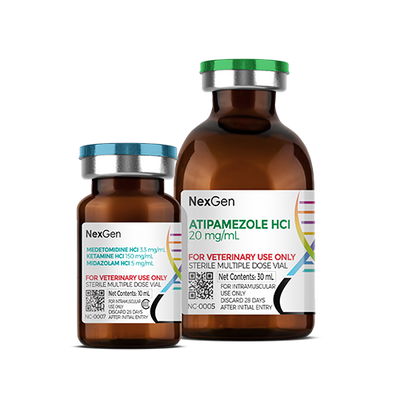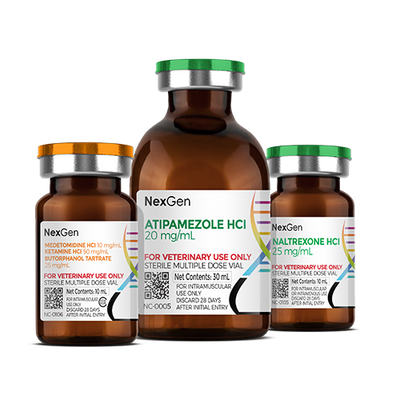
MKBM™ Kit (Sedation & Reversal)
Login for pricing
- Brand
- Mixlab
- SKU:
- NC-0110K
- Product Type:
- Injectable
- Administration:
- Intramuscular
- Size:
- 10ml
- Controlled Substance:
- Schedule CIII
Anesthesia plays a critical role in wildlife veterinary medicine. Relocation and other management procedures, preventive medicine, imaging and surgery are among the key interventions typically carried out on wildlife species and which nearly always require chemical immobilization. Wildlife practice is a highly-specialized area of veterinary medicine, and this is particularly true in the area of chemically immobilizing large and exotic hoofstock.
The modern chemical immobilization techniques which exist today were originally pioneered beginning in the late 1950s by wildlife managers in South Africa. A great many species encountered during the period from the late 1950s through the late 1970s underscored the vast differences between chemical immobilization requirements across large exotic species.
As procedures involved in chemical immobilization developed, veterinarians and wildlife managers sought the optimal drug combinations to effectively anesthetize wildlife species. This period involved a great deal of trial-and-error. While some drugs worked well on certain species, they often did not work well on other or even closely-related species. Some drugs worked very well, but had unforgiving safety margins which could easily lead to the death of an animal.
In recent years, and especially given concerns in the area of conservation and humane treatment, great care has been taken with chemical immobilization protocols and drug development to keep these within safety margins through the use of novel anesthetics, including combinations of true anesthetics, neuromuscular blockers and tranquilizers.2 Thus, modern chemical immobilization techniques have dramatically reduced the side-effects of drugs and mortalities. Additionally, the use of antagonists to anesthetics is now widely employed, as this avoids the undesirable and potentially harmful effects of drugs and facilitates speedy recovery from chemical immobilization events.1,2
Reversal agents (antagonists) are drugs that are used to reverse the effects of anesthetics and narcotics. The drugs and drug dosages for the chemical immobilization of wildlife are highly variable, and factors such as concurrent medications, medical conditions, species, age, sex and other factors contribute to this variability. Consequently, the development of reversal agents and the refinement of their applications are ongoing.
The MKBM™ Kit for Exotic Wildlife Species
The MKBM™ Kit is an original formulation by NexGen Pharmaceuticals, containing
-
Medetomidine hcl 20 mg/ml
-
Ketamine hcl 100 mg/ml
-
Butorphanol 30 mg/ml
-
Midazolam 20mg/ml
The MKBM™ Kit also includes the reversal agents
-
Atipamezole 40mg/ml
-
Naltrexone 50 mg/ml
The MKBM™ Kit is indicated for the chemical immobilization of numerous large exotic hoofstock species. It is an excellent choice for anesthetizing bongo, kudu, gazelle, eland, as well as other African hoofstock and certain domestic wildlife species.
Where to buy the MKBM™ Kit
The MKBM™ Kit is an original formulation available exclusively through NexGen Pharmaceuticals. It is indicated for the chemical immobilization of large exotic hoofstock and other exotic species.
The MKBM™ formulation carries numerous potential drug interactions. Please consult your veterinarian prior to beginning any treatment regimen.
FOR RX ONLY: A valid prescription from a licensed veterinarian is required for dispensing this medication.
1Arnemo, Jon & Kreeger, Terry. (2018). Handbook of Wildlife Chemical Immobilization 5th Ed. Sunquest Publishing, 2007, 432 pages.
2Nielsen, L. Chemical Immobilization of Wild and Exotic Animals. (1999) Ames, Iowa, Iowa State University Press.
4Bouts T., et. al. Detomidine and Butorphanol for Standing Sedation in a Range Of Zoo-Kept Ungulate Species. J Zoo Wildlife Medicine. 2017 Sep; 48 (3):616-626.




















